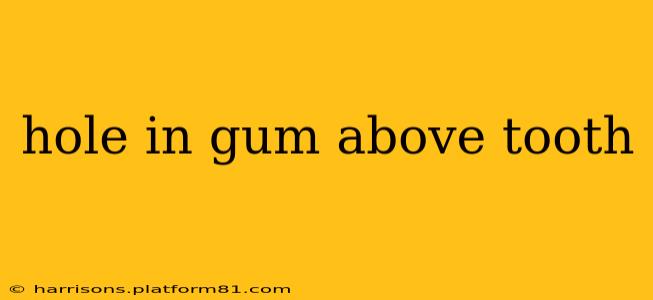A hole in the gum above a tooth, often referred to as a gum recession or periodontal pocket, is a concerning issue that requires prompt attention. This condition can lead to various oral health problems, including tooth sensitivity, tooth loss, and even infection. Understanding the causes, treatments, and prevention methods is crucial for maintaining optimal oral health.
What Causes a Hole in the Gum Above a Tooth?
Several factors can contribute to the development of a hole in the gum above a tooth. The most common cause is gum disease (periodontitis), an infection that damages the soft tissues and bone supporting your teeth. This infection can lead to gum recession, exposing the tooth roots and creating pockets between the gums and teeth.
Aggressive Brushing:
Believe it or not, overly aggressive brushing can also cause gum recession. Using a hard-bristled toothbrush and scrubbing vigorously can damage the gum tissue over time, leading to the formation of these holes.
Genetics:
Genetic predisposition plays a significant role. Some individuals are genetically more prone to gum recession than others. This means their gums are naturally thinner or more susceptible to damage.
Grinding or Clenching Teeth (Bruxism):
This habit puts significant pressure on the teeth and gums, gradually wearing down the gum tissue and leading to recession.
Smoking:
Smoking significantly increases the risk of gum disease, contributing directly to the formation of holes in the gums. It impairs the body's ability to heal and fight infection.
Hormonal Changes:
Fluctuations in hormone levels, particularly during pregnancy or menopause, can make gums more sensitive and prone to recession.
Poor Oral Hygiene:
Neglecting proper oral hygiene practices – insufficient brushing and flossing – allows plaque and bacteria to build up, leading to gum disease and ultimately, gum recession.
How is a Hole in the Gum Above a Tooth Treated?
The treatment for a hole in the gum above a tooth depends on the severity and underlying cause. Mild cases might only require improved oral hygiene and professional cleaning. However, more advanced cases may need more involved procedures.
Scaling and Root Planing:
This deep cleaning procedure removes plaque and tartar from below the gum line, smoothing the tooth roots to promote healing and reduce inflammation.
Gum Grafting:
In cases of significant gum recession, a gum graft may be necessary. This surgical procedure involves taking tissue from another area of the mouth (often the palate) and attaching it to the affected area to cover the exposed root. Different types of grafts exist, chosen based on individual needs and the extent of the recession.
Guided Tissue Regeneration (GTR):
This procedure uses a special membrane to encourage the regrowth of bone and gum tissue around the affected tooth.
Antibiotics:
If infection is present, antibiotics may be prescribed to combat the bacteria and promote healing.
Can a Hole in the Gum Above a Tooth Be Prevented?
Preventing gum recession requires a proactive approach to oral hygiene and regular dental checkups.
Proper Brushing and Flossing:
Brush your teeth gently with a soft-bristled toothbrush at least twice a day, and floss daily to remove plaque and food particles from between your teeth and along the gum line.
Regular Dental Checkups and Cleanings:
Visit your dentist for regular checkups and professional cleanings. Early detection and treatment of gum disease are essential in preventing further recession.
Mouthguards:
If you grind or clench your teeth, consider using a mouthguard to protect your teeth and gums from excessive wear and tear.
Quit Smoking:
Smoking significantly increases the risk of gum disease and various other health problems. Quitting is one of the best things you can do for your overall health, including your oral health.
What are the potential complications of a hole in the gum above a tooth?
Ignoring a hole in the gum above a tooth can lead to severe complications. These include:
- Tooth Sensitivity: Exposed tooth roots are more sensitive to temperature changes and sweets.
- Tooth Loss: Severe gum recession can weaken the support structures of the teeth, leading to loosening and eventually tooth loss.
- Infection: Periodontal pockets can harbor bacteria, leading to infections that can spread to other parts of the mouth or body.
- Bone Loss: Advanced gum disease leads to bone loss around the teeth, further compromising their stability.
Addressing a hole in the gum above a tooth promptly is vital for preserving your oral health. Regular dental checkups, good oral hygiene, and prompt treatment of gum disease can significantly reduce the risk and minimize potential complications. Remember to consult your dentist for a proper diagnosis and personalized treatment plan.
